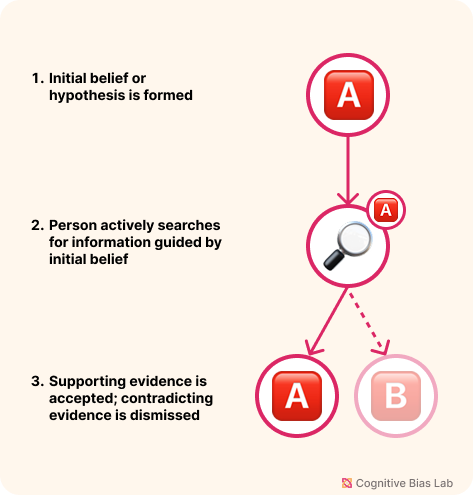Confirmation Bias
Your progress on this bias test won't be saved after you close your browser.
Understanding Confirmation Bias
Confirmation Bias
We tend to seek out and interpret information in ways that support what we already believe, while dismissing or overlooking evidence that challenges those views.
Overview
Confirmation bias occurs when we focus on evidence that confirms our preconceived notions and beliefs, while simultaneously downplaying or dismissing conflicting information. This cognitive shortcut can undermine critical thinking and lead to skewed decision-making.
Key Points:
- Selective Evidence Gathering: People often search for data and testimonies that align with what they already assume to be true.
- Resistance to Contradiction: Facts that challenge prior beliefs may be dismissed, scrutinized more harshly, or overlooked entirely.
- Far-Reaching Effects: Confirmation bias can appear in research, journalism, business, and personal relationships—any context where conflicting data might arise.
Impact: When confirmation bias goes unchecked, it can cause flawed judgments, reinforce prejudices, and hinder innovation. For instance, a company might miss market shifts because it selectively interprets sales data that affirms its current strategy.
Practical Importance: Recognizing confirmation bias is crucial to being open-minded, gathering valid evidence, and making more accurate decisions. By deliberately seeking diverse perspectives, people can build stronger arguments and adapt more effectively to new information.

Visual representation of Confirmation Bias (click to enlarge)
Examples of Confirmation Bias
Here are some real-world examples that demonstrate how this bias affects our thinking:
Psychological Study Simulation
Confirmation Bias: The Wason Selection Task
This simulation recreates Wason's classic 1966 card selection task that demonstrates confirmation bias in logical reasoning. It reveals how we tend to seek confirmatory evidence rather than disconfirming evidence, even when falsification is the best way to test a hypothesis.
Echo Chamber Effect
Imagine you hold a strong political belief. You follow social media accounts and news outlets that align with your viewpoint, while ignoring sources that offer contradictory perspectives. This reinforces your opinion and creates a self-reinforcing loop where opposing arguments rarely enter the conversation.
Medical Diagnosis Pitfall
A doctor suspects a rare illness and orders only the tests that would confirm their initial hypothesis. By overlooking more common explanations for the symptoms, they risk making a misdiagnosis and delivering inappropriate treatment.
How to Overcome Confirmation Bias
Here are strategies to help you recognize and overcome this bias:
Seek Out Dissenting Views
Engage with sources or individuals who hold different beliefs and actively listen to their points. This counteracts the tendency to gather only supporting evidence.
Consider Alternative Hypotheses
Before settling on a conclusion, brainstorm other explanations. Evaluate how these alternatives could account for the same facts or events.
Implement Structured Decision-Making
Use checklists or predefined criteria to evaluate all options equally, ensuring that contradictory information receives the same scrutiny as supportive data.
Test Your Understanding
Challenge yourself with these questions to see how well you understand this cognitive bias:
A postgraduate researcher is investigating the link between social media usage and psychological well-being. They primarily gather data sets that appear to support their hypothesis but do not explicitly reject or suppress any contradictory findings. Does this situation unquestionably illustrate confirmation bias?
Academic References
- Wason, P. C. (1968). Reasoning about a Rule. Quarterly Journal of Experimental Psychology, 20(3), 273–281.
- Piksa, M., Noworyta, K., Gundersen, A., Kunst, J., Morzy, M., Piasecki, J., & Rygula, R. (2024). The impact of confirmation bias awareness on mitigating susceptibility to misinformation. Frontiers in Public Health, 12.
- Born, R. T. (2024). Stop fooling yourself! (Diagnosing and Treating Confirmation Bias). eNeuro, 11(10), ENEURO.0415-24.2024.